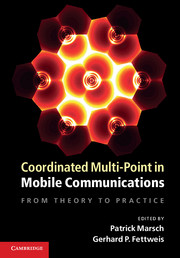Book contents
- Frontmatter
- Contents
- List of Contributors
- Acknowledgements
- List of Abbreviations
- Nomenclature and Notation
- Part I Motivation and Basics
- Part II Practical CoMP Schemes
- Part III Challenges Connected to CoMP
- 7 Clustering
- 8 Synchronization
- 9 Channel Knowledge
- 10 Efficient and Robust Algorithm Implementation
- 11 Scheduling, Signaling and Adaptive Usage of CoMP
- 12 Backhaul
- Part IV Performance Assessment
- Part V Outlook and Conclusions
- References
- Index
8 - Synchronization
from Part III - Challenges Connected to CoMP
Published online by Cambridge University Press: 05 August 2012
- Frontmatter
- Contents
- List of Contributors
- Acknowledgements
- List of Abbreviations
- Nomenclature and Notation
- Part I Motivation and Basics
- Part II Practical CoMP Schemes
- Part III Challenges Connected to CoMP
- 7 Clustering
- 8 Synchronization
- 9 Channel Knowledge
- 10 Efficient and Robust Algorithm Implementation
- 11 Scheduling, Signaling and Adaptive Usage of CoMP
- 12 Backhaul
- Part IV Performance Assessment
- Part V Outlook and Conclusions
- References
- Index
Summary
This chapter deals with another major challenge connected to CoMP, namely the synchronization of cooperating and cooperatively served devices in time and frequency. On one hand, there are different local oscillators in each base station and mobile terminal that lead to deviations in the carrier frequency according to its nominal value. On the other hand, there are variations in the symbol timing between each transmitter and receiver station. Both effects need to be compensated by synchronization techniques.
In cellular networks, we can distinguish between a network synchronization among all involved base stations and the alignment of the user equipments to that time and frequency reference. The basic definitions of the synchronization terms as well as procedures for the reference network synchronization are described in Section 8.1. The impact of symbol timing mismatches on CoMP is then treated in Section 8.2, before Section 8.3 concludes this chapter with the analysis of the impact of residual carrier frequency offsets on CoMP performance.
Synchronization Concepts
Synchronization is the process of establishing a common notion of time among two or more entities. In the context of wired and wireless communication networks, synchronization enables coordination among the nodes in the network and can facilitate applications such as distributed sensing. Precise synchronization can also facilitate scheduling of communication resources as well as interference avoidance in multi-access networks.
- Type
- Chapter
- Information
- Coordinated Multi-Point in Mobile CommunicationsFrom Theory to Practice, pp. 161 - 192Publisher: Cambridge University PressPrint publication year: 2011
- 2
- Cited by



